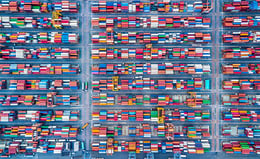The 5 Biggest Areas of Waste in Supply Chain Logistics
Jesse Kelber - September 19, 2019

You know that one product that seems to be in every outgoing order? The one kept all the way in the corner of warehouse 2, opposite from the loading dock? How much is it costing you to keep sending the forklift across 10,000 square feet of warehouse, multiple times per day? What if you moved that item to an empty bay 2 rows away from the docks? How much time, energy, and money would that save your logistics budget? If you don’t know the answer to any of these questions, it’s time to take a good, hard look at the logistics end of your supply chain to weed out the wasteful spending and tighten things up a bit. To get you started, we’ve pulled together a list of our top 5 areas of waste in supply chain logistics. If you can get these under control, you’ll be well on your way to a streamlined value chain and much-improved logistics ROI.
1. Lead Times
While the forklift is traversing the warehouse for that one item, what are your trucks doing? Is there one waiting at the dock for that item to be retrieved? Add up the time spend paying the driver, loaders, and fuel if the truck is idling and you can see what lead time waste is costing. Could the workers who are currently running around filling that order be better put to use loading a second truck at dock 2? If your backend planning and scheduling system is a clipboard and pen sitting on your desk, you may never know. By implementing Logistics 4.0 technologies, you can not only streamline this process, thus eliminating lead time waste, but you can make strides toward full supply chain transparency while you’re at it.
And when your dock foreman can access the warehouse map and real-time tracking on the forklifts collecting the order he’s waiting on from a tablet, he’ll be better able to schedule docks and trucks to further cut idle truck time, saving that budget and improving ROI on the technology. The place to start here is to collect all the information you can get your hands on, from delivery schedules, logistics processes on-site and in the office, warehouse layout and pallet locations. For every recurring 10 minute delay you can find and obliterate, think how much time and money you’ll be able to save the company over the coming months or years. 10 minutes every shift, 3 shifts a day, 6 days a week equals 180 minutes a week or 12 hours a month—and that’s just one recurring delay!
2. Transportation/Routing Issues
Waste in this area includes the obvious, like extra fuel costs due to idling trucks, incomplete loads, and unpredictable costs of the fuel itself. Add to that extra stops caused by sharing truck space with other deliveries, badly routed deliveries getting stuck in traffic or delayed by weather incidents and multiple hops before deliveries actually get on the road, and once again the waste becomes apparent. Do your trucks go from warehouse to warehouse before leaving town to start delivery runs? Can you reschedule them so they only have pickups from a single location and send different trucks to the other warehouses? Is the problem that a single order is stored in multiple locations, or is this caused by a simple lack of communication between the production planner and you, the logistics planner? Finding these issues and putting in place new processes that address communication breakdowns is the first step to eliminating transportation waste.
3. Inventory Mismanagement
We’ve hinted at issues in this area already, but inventory mismanagement is a huge source of logistics delays. Go back to our initial example of the common item stored at the opposite end of the warehouse from the loading docks. That’s a delay in stocking the item when it arrives, and another delay waiting for it to be brought out and loaded for delivery. How about empty shelf space? Or unused inventory that just sits there, taking up valuable space and resources when nobody is ordering it? The costs associated with storing goods that aren’t selling and mishandled incoming supplies are one thing. Add to that the increased chance of damage when your forklifts have to carry inventory long distances while navigating the congested warehouse floor—and you can see the issue here. And all that’s before the goods get anywhere near the waiting trucks.
4. Misuse of Internal Resources
In this case, we’re referring to your current workforce. The goal is to reduce waste. And in order to do that, you need to find the sources of the waste, right? Who is better positioned to be able to identify the unnecessary spending, wasted resources, or other inefficiencies than the folks down on the floor or in the truck cabs? Send out surveys, mount “feedback” boxes around the warehouse, and bring it up in staff meetings. Ask your people on the ground what they’re seeing day in, day out. Then, offer incentives for locating sources of waste—gamify your cost-cutting activities. You might be surprised what they have to say, and you might end up wondering what took so long to ask.
5. Last-Mile
Increasingly, carriers are implementing size-to-weight based fees for packages that include too much air. You know the ones, the 2’x3’ boxes that arrive with a single 9” stuffed animal floating in a sea of packing peanuts. These shipments aren’t just irritating to the customer, they’re also expensive for the LTL shipper and they’re passing those costs on to manufacturers. Luckily, emerging AI-based cartonization solutions are coming to market that use algorithms straight out of the gaming industry to cut these costs. They do this by optimizing not only the individual boxes but the pallets and entire shipping containers at once. The potential cost savings here are game-changers for not only manufacturers but also the LTL companies and ultimately the consumer as the savings can be passed all the way along the value chain.
In the end, the key to any cost-cutting endeavor is to start at the end and work backward. That is, start from the end customer and work back through your logistics chain to the production floor where the product starts its final journey. By tracking waste back through your supply chain from final delivery costs, through transportation overspending and inventory efficiency you’ll be able to locate the root causes and eliminate them. And in the end, that’s going to keep everyone happy by lowering overhead, increasing ROI, and delivering the best possible service to your customers.
WANT MORE INFORMATION?
LATEST POSTS
- Understand Circular Economy in The Manufacturing Industry
- How Can Industry 4.0 IT Integration Be Achieved Smoothly?
- The Significance of Order Sequencing in Discrete Manufacturing
- How to improve your Supply Chain Management: The Power of Control Towers
- Optimizing Human Resource Scheduling in Manufacturing: A Technological Approach



